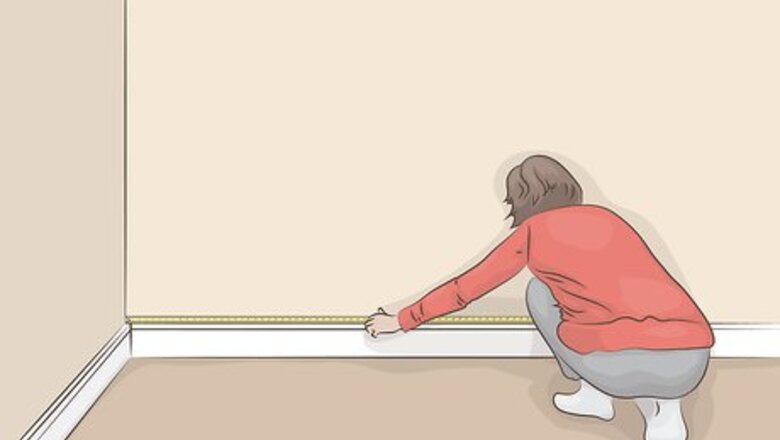
views
- Take measurements of the room’s walls, windows, doors, and built-in features using a tape measure.
- Convert your measurements to a smaller scale using a scale ruler or graph paper. For example, your scale could be ¼” = 1’ (¼ in. = 1 ft.)
- Draw the room’s walls and built-in features on a sheet of graph paper or plain paper using your scale as a reference.
- Sketch out any movable furniture on a separate sheet of paper using your conversion scale, then cut the drawings out and place them on your scale drawing.
Measuring & Sketching Room Dimensions
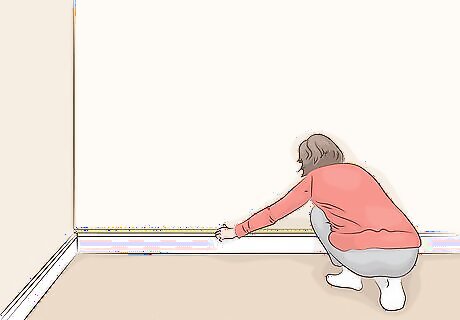
Measure the walls from corner to corner using a tape measure. Run a tape measure from corner to corner on top of the baseboard (if there is one) or along the floor against the walls. If there’s a lot of furniture or other things in your way, use a stepladder and measure along the ceiling. If you’re just trying to figure out if a new furniture layout will fit, measuring to the closest half-foot (or quarter-meter) might be sufficient. However, if your goal is to add new kitchen cabinets, be as precise as possible (to an eighth of an inch or millimeter, for example).
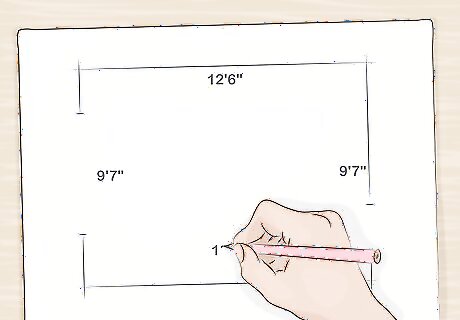
Draw a rough sketch of the room and write in the measurements. Skip the ruler or graph paper and just use a pencil and blank paper. If you’re measuring a basic rectangular room, simply jot down your 4 measurements next to the corresponding walls. If the room has walls that jut out or sink in in certain places (such as for a closet) add those measurements as well in the appropriate spots. Write down feet/inches measurements as 10’3¼” (10 feet 3¼ inches), and metric measurements as a decimal (i.e., 4.5m).
Drafting to Scale with a Scale Ruler or Graph Paper
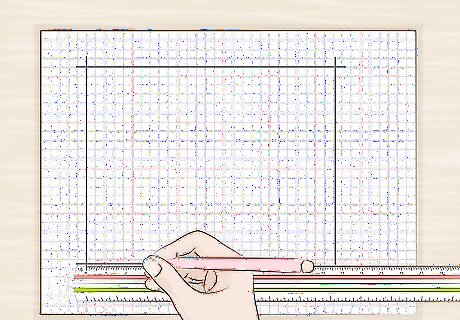
Convert your measurements with a scale ruler for precision. A scale ruler (or architect’s scale) looks like a triangular-shaped ruler and can adjust measurements to your preferred scale quickly. The different sides of the scale are marked with different common scale ratios—for instance, ¼” = 1’ (¼ inch = 1 foot), which is common for architectural drawings. Once you find the side with your preferred ratio, do the following steps: Lay your chosen side of the ruler on your paper. Draw a line on the paper from the zero mark on the ruler to the number mark on the ruler that matches the length of the wall you’re drawing. For example, if the scale is ¼” = 1’, and the wall you measure is 11 feet, you would draw to the eleventh ¼” mark. If you don’t have a scale ruler, use a regular ruler and come up with a scale that fits its measurements. For example, have ½ inch on paper equal 1 foot in real life.
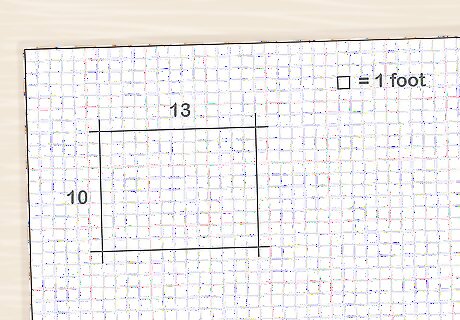
Use a “one square equals one foot” scale on graph paper for simplicity. If you don't have a scale ruler, a typical 8 in × 10.5 in (20 cm × 27 cm) sheet of graph paper with a grid of 0.25 in (0.64 cm) squares will work just fine. At this size, you’ll find approximately 41 squares running along the long side of the paper and 31 squares on the short side. So as long as the room isn't bigger than 40 ft × 30 ft (12.2 m × 9.1 m), a single square can represent one square foot.Note: For a general equivalent in metric measurements, make each square equal 25 cm. This will make every 4 squares equal 1 meter. This ¼” = 1’ scale (also represented by the ratio 1:48) is very common in architectural measurements in the U.S.
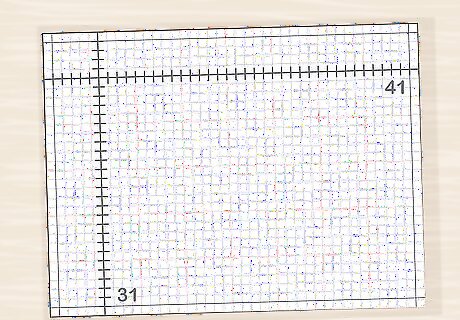
Calculate the maximum scale you can use to draw your plan in feet and inches. If your graph paper is 41 by 31 squares, reduce it to 39 by 29 to provide some space around the edges of the paper. If your room is a square or rectangle, round the measurements up to the next whole foot (e.g., 10’2” x 8’6” becomes 11’ x 9’). If it isn’t, determine the smallest square/rectangle (rounded up to the nearest whole foot) that the entire room would fit into. Then: Multiply the square/rectangle measurements (e.g., 11’ and 9’) by 2, 3, 4, and 6. In this case, you’ll get 22’ x 18’, 33’ x 27’, 44’ x 36’, and 66’ x 54’. Use the pair of multiplied numbers that are closest to 39 x 29 without going over. In this case, it is 33’ x 27’ (the multiple of 3). Since the multiple of 3 fits the parameters, draw your plan so that 3 squares equals 1 foot.
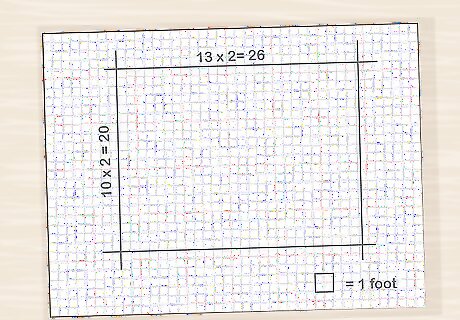
Make your plan larger on graph paper using metric measurements. Reduce the number of squares you’ll use on the graph paper (e.g., 41 x 31 to 39 x 29) to create some space around the edges. Take your room measurements and round them up to the nearest tenth of a meter (e.g., 4.23m x 3.37m becomes 4.3m x 3.4m). Or, find the smallest square/rectangle (rounded up to the nearest tenth of a meter) into which a non-square/rectangular room will fit. Then: Multiply the square/rectangle measurements (e.g., 4.3 x 3.4) by 2, 4, 5, and 10. In this case, you’ll get 8.6 x 6.8, 17.2 x 13.6, 21.5 x 17.0, and 43.0 x 34.0. We use 2, 4, 5, and 10 in this case so that the decimals come out as nice even numbers. Use the pair of multiplied numbers that are closest to 39 by 29 without going over. In this case, it’s 21.5 x 17.0 (the multiple of 5). Since the multiple of 5 fits the parameters, draw your plan so that 5 squares equals 1 meter.
Adding Doors, Windows, and Built-In Fixtures
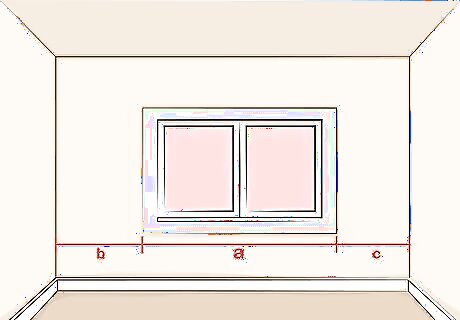
Measure all doors and windows in the room. Measure the width of each door and window opening (without frames), as well as the distance from each side of the door or window to the edge of the wall. Then, convert these measurements to your chosen scale.Example: A 3’-wide window will be represented by a ¾”-wide mark on your floor plan if you’re using a ¼” = 1’ scale.
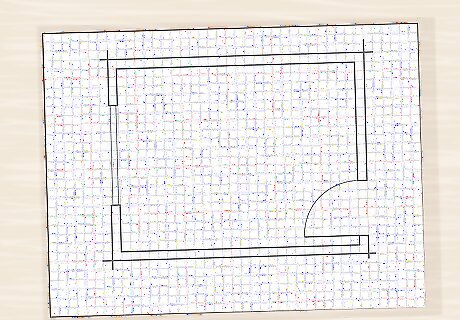
Draw the walls, windows, and doors into your floor plan. Draw each window as a set of double lines and each door as a single line with an arc. The single line represents the door, while the arc represents the path it takes when it swings open. Make sure you place each in the right position along the walls in your scale drawing.Example: If a door’s edges are 6’ from one wall corner and 8’ from the other, the edges should be 1½” and 2” from the corners of your scale wall when using a ¼” = 1’ scale.
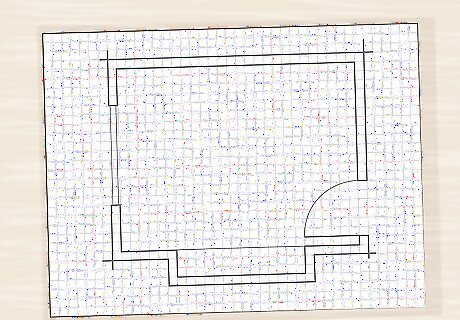
Measure and convert the widths of all built-in fixtures. These include things like counters and vanities. Use a tape measure to find their width and length, then convert them to scale and add them to your plan in the appropriate locations. You can find common architectural symbols for windows, doors, counters, vanities, and other room elements at http://www.the-house-plans-guide.com/blueprint-symbols.html.
Drawing Movable Furniture to Scale
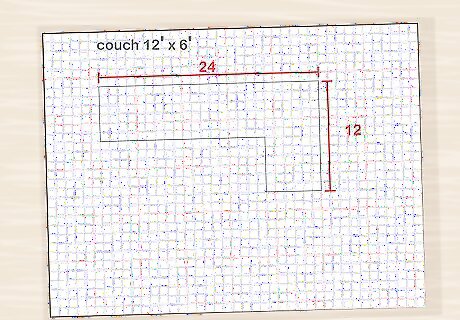
Convert the length and width of each piece of room furniture to scale. For instance, a 5’ x 2’ dresser would be represented by a 1 ¼” x ½” rectangle if using a ¼” = 1’ scale. Similarly, a 4’ x 4’ table would be a 1” x 1” square. For furniture that isn’t square or rectangular, find the smallest square/rectangle into which the piece will fit and use those measurements. For instance, if a wingback chair has a maximum width of 2’6” and a length of 2’, represent it with a 2 ½” x 2” rectangle (using the ¼” = 1’ scale). Then, sketch the general shape of the chair within the rectangle.
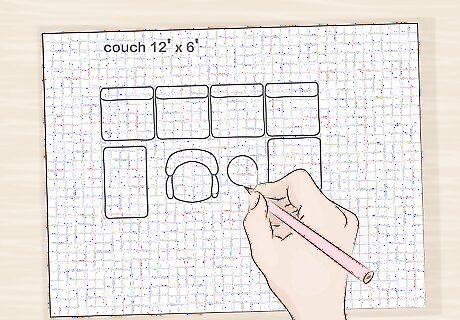
Draw the furniture on a blank sheet of graph paper. Use a different sheet of graph paper to sketch your scale drawings of each furniture piece. Make sure all your sheets of graph paper use the same size blocks—typically 0.25 in (0.64 cm). If you’re using a scale ruler or regular ruler instead of graph paper, just draw the furniture plans on blank paper to the same scale as the floor plan.

Cut out the individual pieces of furniture with scissors. If you want to make the cutouts a little more rigid and sturdy, glue each one to a piece of card stock or thin cardboard and cut around your drawing. If you haven’t already labeled each piece of furniture, jot down the name in the center of the cutout, or use a number to represent each piece.
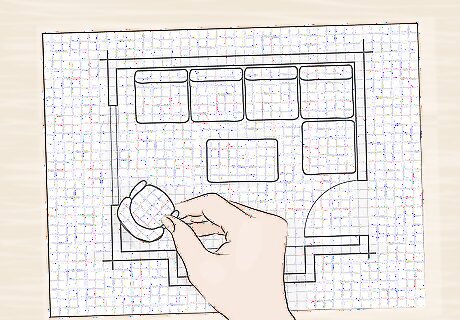
Move the cut-out furniture around your floor plan. This can help you to decide on a suitable arrangement for the furniture in the room. It’s certainly much easier than moving the actual furniture around the room.Tip: This is a great idea if you’re buying new furniture for a room, or if you want to freshen up the layout of existing furniture in a room.




















Comments
0 comment